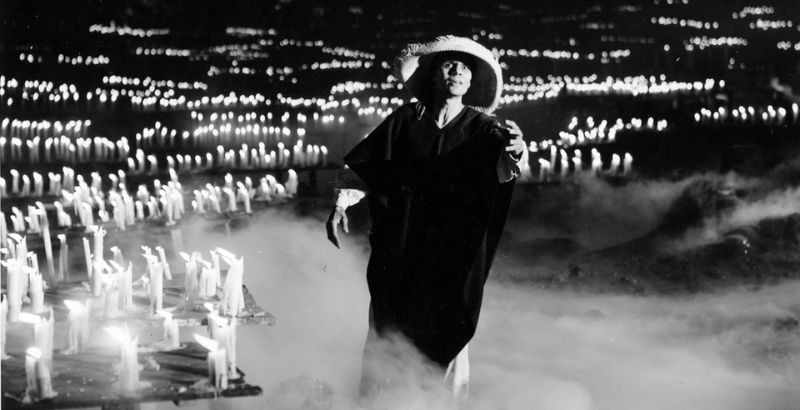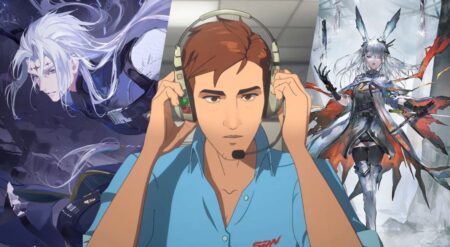Horror is in my bones. It’s in my DNA. It’s a vital piece of who I am, and it wasn’t just because I watched a slasher and fell in love – while that also happened. No, horror is vital to who I am because of how I grew up. My Mexican-American identity is essential in understanding my love of the genre. It’s in the stories that grandma told me that my mom repeated. It’s in the ways that they scared me to behave and taught me vital lessons about life. Mexican horror is my identity, it’s who I am.
Similarly to Guillermo del Toro, when I’m asked about connecting to darkness, and to the stories that come from it, my answer is, “because I’m Mexican.” I don’t remember a time that I wasn’t afraid of the dark as a kid. My grandfather’s room which had his hunting rifles, was the “cucuy room.” The room in the house that if you entered, the cucuy, a boogeyman type man, would get us. That was way more effective for my cousins and me as we played in my grandma’s house than a simple “don’t go in there.” The thought of being taken away and possibly eaten, depending on which tía told the story, stuck with me when I started watching horror with my family.
The Mexican horror of the “cucuy room” in our houses made me that much more scared of slashers, boogeymen, and the things hiding in the dark, waiting to take the final girl away. It wasn’t just a story as a child; it was reality. But while my mom made sure to let me know that Michael Meyers was not real, she never corrected my belief in the cucuy. That said, the cucuy fueled my love of the slasher subgenre, but most importantly, it made Freddy Krueger hit me in such a visceral way.
A killer who comes into your dreams, changes shape, and is inescapable fits so well into the stories my mom, her sisters, and my grandma told us. As the cucuy changed shape depending on whose house we were at, I saw this boogeyman and Freddy as the same. My cousins, they had similar experiences but with different icons. Jason and Chucky were two of the biggest ones. And while we all developed a beautiful relationship with horror, as children, we were all terrified. Now that I think back on it, this is where I found a community for the first time. Literal family, yes, but we thrived and loved each other through our fear. As we grew older, we began making our own scary stories, sitting in a dark room, trying to scare each other and bonding over that most primal of emotions: fear. I also connected to my other Mexican and Latinx friends at school who had the same monster in their home. We’d compare stories and because they also had a “cucuy room,” it was all the more real for me. We made everything Mexican horror even it wasn’t.
Angela Aguilar – La Llorona – Video Oficial
Primer video del album “Primero Soy Mexicana” a la venta digital en iTunes y en todas las plataformas digitales. Video dirigido por Kai Parlange. Escucha a Angela Aguilar en todas las plataformas digitales: https://ONErpm.lnk.to/AngelaAguilar Escucha la playlist Hecho en México https://ONErpm.lnk.to/HechoEnMexico
The cucuy isn’t the only reason I love horror; La Llorona is as well. As one of the most well-known legends, she is also known as the weeping woman. The story goes that she is the spirit of a woman who was the mother of two young children. After falling in love with a man, he rejects her when he discovers that she has children and leaves. Filled with anger and longing for her lover, she takes her children to the river behind their home and drowns them. When she went to the man to win him again, he is repulsed by her actions and rebukes her. Stricken with grief the woman kills herself. Now, she wonders the darkness crying for her children.
That, my friends, was a story I grew up with. It defined my childhood in a way, and I can’t remember a time that I didn’t know this folk tale. When we would stay outside past dark my wela would cup her hands around her mouth and cry into the night and yell out, “donde estan mis hijas” from her open window. In the pitch black, we would book it to the house, running from the wailing woman, knowing that if we weren’t fast enough she would steal us away in the night and replace her children with us.
Much like with the cucuy, this strong belief in the supernatural drove me to not only cover my eyes and fear ghost stories but also pushed me to seek them out. It wasn’t about suspending disbelief for me, it was about finding it belief and reality at the altar of ghost stories. Specifically, I found this in Japanese horror and its kaidan (ghost stories). Many Japanese ghost stories are rooted in revenge trauma, the same as ours – the same as La Llorona. This connection was beautifully blended in AMC’s The Terror: Infamy. In that series, set in a Japanese internment camp, we got to see a Japanese ghost story from the Japanese American perspective that also added an element of Mexican mysticism, magic, and of course, a moment that calls to La Llorona—threading Mexican and Japanese horror together.

Being Mexican means that I see death in a different way. We don’t think it’s something that will never come. Instead, our culture sees it as a reality and not something to reconcile within your old age. Del Toro said it best in his response to how he balances darkness with the good. “No one loves life more than we do, in a way, because we are so conscious about death…So the preciousness of life, standing side by side the one place we’re all going to.” While there is nothing scary about Dia de Muertos (Day of the Dead), it is something that has normalized the idea of death. It’s something that has made me seek out the macabre. Horror, at its root, is how we showcase our fears, and for many creators, that is marked by death.
I’m an atheist now which means I don’t believe in god, ghosts, or anything that isn’t science anymore, but that doesn’t erase the time I felt marked by it. It’s because of this pat that I lean on the way horror rooted itself in my identity and in my bones. I don’t know how to explain it, but, growing up, the world was magical. While I know all children believe this to an extent, Mexicans view the world as magical, in a sense. We have our superstitions, the things we do because we’ve always done them, and our communities are built around them. The supernatural is baked into my culture. When I realized I was an atheist, I struggled with this. How could I connect to this magical world that my family saw when I believed in absolutely none of it? The answer was simple: horror.
When I left my belief in the magical world my family saw and still see, I worried that I would feel hollow like a part of me was gone. And I did, for a while. Then horror called me back, and I made a home there. I clutched to the Mexican horror stories from my childhood and I followed them back to a genre that has always been there for me. While I don’t believe in fear anymore in a real way, I have connected to a horror family again.
Over the past decade, I’ve been able to fill the void that my disbelief in the supernatural left. Meeting horror fans allowed me to find the wonder that I thought I had lost. Watching horror, reading it, and then talking to others about it helped me process more than the films we were enjoying together, it also helped me unpack why I came to love it from a young age.
Once, while discussing how we got into the genre, a friend expressed how Scream was their moment. When it came time for me to respond, this wasn’t a question I had been asked before. I realized that I don’t remember a time when I didn’t love being scared or a moment before living in horror. I love horror because I don’t remember a time in my life without.

The ghosts, the demons, the slashers hiding around the corner are vehicles for community-building for me now the way the cucuy, La Llorona, the Donkey Lady, and all the other weird stories that I shared with every other Mexican kid in my elementary school classes united us in fear.
Out of all of the conventions and festivals I’ve covered, nothing has made me feel more at home than Fantastic Fest. When I covered it last year, I was met with open arms by genre fans. But, to top it off, 2019’s festival was done in partnership with the Mexican Consolute in Austin. When I walked into the venue I was greeted with luchador masks, calaveras, and programming that celebrated Mexican horror cinema. It was wonderful. It was honoring the connection we have to the genre and it was done in such a way that avoided every stereotype. I felt at home not only because of the theme but because everyone I talked to was sharing their stories of getting started in horror.
They talked about how they began as critics, how they found safety in horror stories when they didn’t have other communities to turn to, and then when it came to me, I got to share my stories. I got to tell them about how I saw the cucuy in Freddy, how La Llorona made J-horror classics even more potent for me, and ultimately, we shared our favorite films of the festival. In that space, at that festival, I got to bring all of me.
The horror community I’ve become apart of through r/horror, the subreddit known as the Dreadit, and those I’ve met at festivals and online may not be all Latinx or Mexican, but we share the same love of stories – the same passion for being scared. We bond over directors like Issa Lopez and Gigi Saul Saucedo, and Guillermo del Toro. We talked about our hopes for the genre and the types of films that sing to us. I’m in a space where being scared connects me to others, and the “cucuy room” prepared me for that. Mexican horror is who I am.








